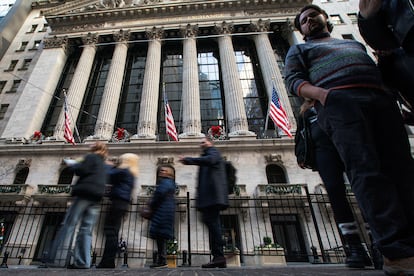Mexican debt, Wall Street’s new darling
The ‘nearshoring’ narrative, strength of the exchange rate and economic expansion have convinced international markets, which support a historic bond issuance: the $7.5 billion placed this week exceed the total debt issued during the entire 12 months of recent years

The recent issuance of Mexican debt bonds in international markets represents “the largest issuance in its recent history,” according to the Mexican government, and Wall Street had such an appetite for them that it is demanding three times the initially offered amount. This enthusiasm comes despite criticism of Andrés Manuel López Obrador’s government for protecting the state’s energy sector monopoly and seeking a confrontation with its main trading partner in agriculture. The nearshoring narrative, a strong exchange rate and surprising economic expansion have helped the country pay relatively low rates.
On Tuesday, Mexico issued $7.5 billion in debt bonds. That makes it the country with the most debt circulating in the international market among BBB-rated countries, such as Italy, Peru, Cyprus, Hungary and Indonesia. The Ministry of Finance went to the market on the first business day of the year, as has become customary in Mexico for the last ten years, to send a message of fiscal and economic strength, as well as to get ahead of the competition.
To appreciate the magnitude of this month’s overwhelming issuance of sovereign bonds, one needs only to compare it with past figures. The $7.5 billion of this first week of the month exceeds the total amount of debt issued during the entire 12 months of recent years. It is more than the 5 million issued in 2016 and almost double the 4.8 million issued in 2019. The sweet moment that the Mexican economy is currently experiencing can be encapsulated by a catchphrase on the Wall Street trading floor these days: “Mexico is the darling of the markets.”
Legislators and analysts abroad have expressed their dissatisfaction with the legislation that López Obrador has promoted to guarantee a monopoly for state companies in the energy sector; the former consider the policy to be protectionist and a violation of the Mexico-United States-Canada trade agreement. In addition, the Mexican president’s insistence on banning GM corn imported from the U.S. has generated friction between the trading partners. But Luis Gonzali, a mathematician and financial strategist at Franklin Templeton in Mexico City, believes that the narrative of Mexico as a country that has everything it needs to capture foreign investment in the coming years has prevailed.
“We started 2023 with a higher country risk,” says Gonzali, referring to the 130 basis points of credit default swaps (CDS). These now quote at close to 90 basis points. “That has to do with several factors, including the fact that we grew more than last year, the fact that the exchange rate got so much stronger, which makes it easier to pay debt in dollars, and the current narrative in Mexico around nearshoring, the narrative that Mexico has a resilient economy there, is improving.”
This reduction in the country’s risk premium makes it an optimal time to issue new debt, and the rates negotiated by the Ministry of Finance reflect that. $1 billion were issued at a rate of 5.07% for five years, 37 basis points cheaper than in January 2023, according to the agency. $4 billion were issued for 12 years at 6.09%, 30 basis points cheaper than a year ago, and $2.5 billion for 30 years that will pay a rate of 6.45%, only 11 basis points more expensive than the bonds issued in April of last year. As Gonzali explains, “debt has become more expensive all over the world,” stemming from an increase in central banks’ interest rates to contain high inflation. But he adds that “these rates are good for Mexico.”
On Wednesday, Gabriel Yorio, the Undersecretary of Finance and Public Credit, posted on social media, that with this issuance, the debt level is lower than 48% of the Gross Domestic Product (GDP).However, that implies a considerable increase, as announced in September, when the Ministry of Finance presented its 2024 budget to Congress. The budget deficit is almost 1.7 trillion pesos, equivalent to 4.9% of the Gross Domestic Product (GDP), a level not seen since 1989. Most of the funds will be used to complete López Obrador’s signature infrastructure projects, as well as to increase social spending to the “unprecedented” level of 12.8% of GDP.
La emisión que realizamos ayer desde @Hacienda_Mexico es muy importante por varias razones:
— Gabriel Yorio (@GabrielYorio) January 3, 2024
🔸Tuvo una demanda sin precedentes de 21 mil millones, demostrando la confianza global en México.
🔸Logramos tasas más bajas gracias a una percepción positiva de nuestra economía que…
“We continue to issue debt bonds, there is an appetite for them, the credit rating is stable and the economy’s fundamentals remain good,” Gonzali says. “But all eyes are going to be on next year’s budget.” In June, Mexico will head to the polls to elect a new president. “We’ve been running high deficits for two years and luckily we’ve had a favorable exchange rate and growth, but we can’t count on that continuing. I think a discussion going forward is going to be the new administration: how is it going to treat indebtedness?”
Sign up for our weekly newsletter to get more English-language news coverage from EL PAÍS USA Edition
Tu suscripción se está usando en otro dispositivo
¿Quieres añadir otro usuario a tu suscripción?
Si continúas leyendo en este dispositivo, no se podrá leer en el otro.
FlechaTu suscripción se está usando en otro dispositivo y solo puedes acceder a EL PAÍS desde un dispositivo a la vez.
Si quieres compartir tu cuenta, cambia tu suscripción a la modalidad Premium, así podrás añadir otro usuario. Cada uno accederá con su propia cuenta de email, lo que os permitirá personalizar vuestra experiencia en EL PAÍS.
¿Tienes una suscripción de empresa? Accede aquí para contratar más cuentas.
En el caso de no saber quién está usando tu cuenta, te recomendamos cambiar tu contraseña aquí.
Si decides continuar compartiendo tu cuenta, este mensaje se mostrará en tu dispositivo y en el de la otra persona que está usando tu cuenta de forma indefinida, afectando a tu experiencia de lectura. Puedes consultar aquí los términos y condiciones de la suscripción digital.
More information
Archived In
Últimas noticias
Most viewed
- Reinhard Genzel, Nobel laureate in physics: ‘One-minute videos will never give you the truth’
- Oona Chaplin: ‘I told James Cameron that I was living in a treehouse and starting a permaculture project with a friend’
- Pablo Escobar’s hippos: A serious environmental problem, 40 years on
- Charles Dubouloz, mountaineering star, retires at 36 with a farewell tour inspired by Walter Bonatti
- Why we lost the habit of sleeping in two segments and how that changed our sense of time











































